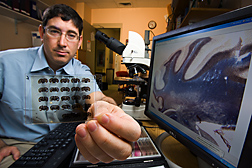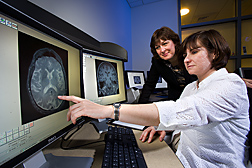Third in a Series:
Nutrition and Brain Function
Boosting Our Knowledge ofBrainFood
|
|
Aging. While everybody’s doing it at the same time, some people are more successful at forestalling its effects on cognition, or mental agility, than others. Cognitive function is measured by the level at which the brain is able to manage and use available information for activities of daily life.
“Loss of cognitive ability robs quality of life and independence,” says ARS-funded physician Irwin H. Rosenberg, who heads the Nutrition and Neurocognition Laboratory at the Jean Mayer USDA Human Nutrition Research Center on Aging (HNRCA) at Tufts University in Boston, Massachusetts. “As the world population grows and the number of senior citizens increases, dementia is becoming a big problem.”
Dementia is the progressive decline in cognitive function—such as memory, attention, language, and problem solving—due to a diseased or damaged brain rather than to normal aging.
“The fact that many individuals maintain their full mental faculties into old age suggests that cognitive decline is not a necessary feature of normal aging,” says Rosenberg. “But aging may affect the brain’s need for nutrients that are involved in normal brain metabolism, such as synthesis of neurotransmitters and maintenance of brain-cell signaling, connectivity, and repair capacity.” Adjusting dietary intake of certain nutrients could eventually prove to be key to forestalling cognitive decline.
At some point, there will be more people in the United States older than age 65 than there are children, according to estimates. Researchers at HNRCA have been conducting intervention trials, population studies, and laboratory tests to learn how a variety of nutrients and biochemicals affect cognitive decline for this growing demographic group.
Homocysteine: A Suspect Biomolecule
Several HNRCA researchers are looking into whether elevated blood levels of the amino acid homocysteine are involved in cognitive decline—and if so, how.
Homocysteine is a byproduct of the body’s metabolism of methionine, an essential amino acid. Unlike other amino acids, homocysteine is not used by the body to build protein. Instead, it can be converted back to methionine or to cysteine, another amino acid, through a reaction with certain B vitamins. In individuals with deficiencies in those particular B vitamins, homocysteine may accumulate in the blood. This buildup is suspected to irritate blood vessel linings and encourage the development of atherosclerosis, or “hardening of the arteries.”
At HNRCA, neurobiologist Aron Troen has been studying laboratory mice to understand how nutrition might affect age-related cognitive decline in humans. “We are looking at the impact of nutrition on brain blood vessels, chemistry, and other pathways,” he says. One of his recent studies suggests that all cases of high homocysteine may not have the same effects on the body’s organs.
Troen fed young mice genetically predisposed to atherosclerosis one of four diets with differing B-vitamin and methionine contents for 8 weeks. Troen then conducted psychomotor, spatial, memory, and learning tests with the mice. He found that low B-vitamin intake was associated with memory and learning dysfunction, whereas excess methionine intake was associated with accelerated blood vessel disease.
“This suggests that different nutritional impairments leading to high homocysteine levels may also lead to different end-organ dysfunctions,” says Troen. “The diets that led to cognitive deficits were different from those that led to further vascular disease.”
|
|
The Age of Folate Fortification
Folate is one of the B vitamins that affect the balance of homocysteine levels. A link between high blood folate levels and relatively lower homocysteine levels has long been known.
Since 1998, all U.S. enriched cereal grain products, such as bread, pasta, flour, breakfast cereal, and rice, have been required to be fortified with folic acid—the synthetic form of folate—to help prevent certain birth defects.
Since fortification began, not only have folate deficiency and birth defects decreased, but so has the prevalence of high homocysteine levels, according to Rosenberg and colleagues. High homocysteine levels are associated with an increased risk of developing heart disease, stroke, dementia, and Alzheimer’s disease.
“It is possible that this drop in the population’s homocysteine concentrations may also bring about a lower incidence of these diseases,” says Troen. “But whether this will be the case is not yet certain. And though there are clear benefits of increasing the population’s folic acid intake as a whole, new research suggests that there may be a downside for some individuals.”
B Vitamins and Brain Power
Epidemiologists Paul Jacques and Martha Morris, biochemist Jacob Selhub, and Rosenberg recently completed a study of the interrelationships among the B vitamins and cognitive function in this age of folate fortification. B vitamins are involved in the synthesis of chemicals crucial to brain function. Scientists have long known that being seriously deficient in vitamin B12 leads to impaired cognitive function due to neurological complications. The researchers used a combination of blood markers to classify subjects’ vitamin B12 ranking.
Morris, who led the study, found that among people aged 60 and older, those with high blood levels of folate and normal, or adequate, vitamin B12 status scored high on cognitive function tests. These seniors were given a test that required response speed, in addition to attentiveness, visual-spatial skills, associative learning, and memory.
But what about those who had low vitamin B12 blood levels—a status that is common among seniors due to the poorer gastrointestinal conditions that come with aging? Low vitamin B12 status was linked with lower scores on cognitive tests.
“The people with high folate and low B12 status were more likely to exhibit both cognitive impairment and anemia than those with normal folate and low B12 status,” says Jacques.
The researchers recommend that future studies examine the implications of having high folate status due to fortification and too little vitamin B12 due to aging.
What’s in a NAME?
Population researcher Katherine L. Tucker is focusing on vitamins and cognition in a series of community-based studies. In the Normative Aging Study, a longitudinal study of originally healthy men in the Boston area, she and colleagues found that those with the best B-vitamin status at the start, or baseline, had little change in their cognitive-function test scores. But test scores went down significantly in the men with the lowest baseline B-vitamin status and highest homocysteine concentrations.
Rosenberg and Tucker are also working with another high-risk group: homebound elderly. “The Nutrition, Aging, and Memory in Elders, or NAME, study is designed to look at the relationships among levels of several nutrients and subsequent cognitive function,” says Tucker.
“We are studying folate, vitamin B6, vitamin B12, vitamin C, and vitamin E intakes among this population, along with each individual’s cognitive functioning,” she says. The data generated may be useful in developing dietary strategies and supplementation targets to help the elderly maintain their cognitive function.
These and future studies are essential to determining whether—and to what extent—nutritional factors can be used to prevent cognitive impairment as we age.—By Rosalie Marion Bliss, Agricultural Research Service Information Staff.
This research is part of Human Nutrition, an ARS national program (#107) described on the World Wide Web at www.nps.ars.usda.gov.
To reach scientists mentioned in this article, contact Rosalie Bliss, USDA-ARS Information Staff, 5601 Sunnyside Ave., Beltsville, MD 20705-5129; phone (301) 504-4318, fax (301) 504-1486.
Brain Development, From the Beginning
Healthy newborn babies sponge up information from their surroundings. All the while, their developing brains are sprouting billions of nerve cell connections, or synapses. The brain’s “hardwiring” actually starts in the womb, directed by the growing fetus’s genetic game plan acquired from both parents.
At the ARS-funded Arkansas Children’s Nutrition Center in Little Rock, researchers in the Brain Function Laboratory are studying how diet and nutrition affect central nervous system development from birth. They are using noninvasive tools to assess infant, toddler, and school-age children’s psychoneurophysiological development and other brain-related functions.
“We’re now planning to use functional magnetic resonance imaging (fMRI) to measure brain activation in 8-year-olds while they are engaged in visual language-related tasks,” says psychophysiologist R. Terry Pivik, who heads the laboratory. Pivik and colleagues will use the fMRI brain-activation patterns and recordings of brain EEG activity to study the influence of dietary factors on the children’s physiological and cognitive development.
Another project, called “The Beginnings Study,” aims to define best feeding practices for brain development in infants and children. The researchers are using measures of brain activity, behavior, and growth to study hundreds of infants who have been reared exclusively on either breast milk, cow’s-milk formula, or soy-based formula. Any differences “will require further evaluation in the context of other factors, such as family socioeconomic status and parents’ education,” says neuroendocrinologist and center director Thomas Badger.
Experts now think that the brain undergoes a second wave of dramatic functional changes during adolescence. Even into old age, the brain continues to adjust itself in response to new learning and experiences. ARS research aims to shine light on the nutrients that are required to keep the human brain’s circuitry healthy and engaged across the life span.—By Rosalie Marion Bliss, Agricultural Research Service Information Staff.
"Nutrition and Brain Function: Boosting Our Knowledge ofBrainFood" was published in the November/December 2007 issue of Agricultural Research magazine.









